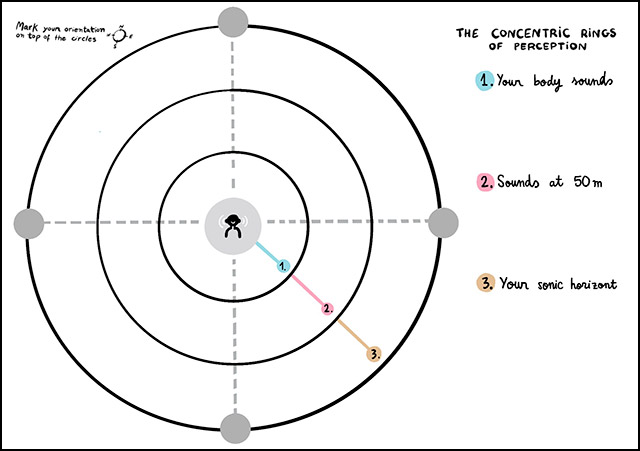Loading...
TOOLKIT

The concentric rings of perception(senses awareness)
LOCATIVE MEDIA SUPERCLUSTER
Improving our connections with people by cultivating a sense of belonging to Nature by Fred Adam & Geert Vermeire
This set of practices is meant to improve our connection with people by opening our senses and feeling the beauty of Nature. But it is also about acknowledging the intelligence of the more than human world, listening to the polyphony of languages, interactions and connections going on around us and with us. We belong to the natural world and we are part of it. Intelligence is not only ours, it is the result of millions of years of evolution. Our ability to develop a greater intimacy with nature is a powerful way to expand our sense of belonging, a shared identity and our love for people because we are all Nature.


illustration by Chari Cámara @doctora.creativa
DURATION
30 minutes to 1h
The aim of the activity is to introduce to the art of deep listening and deep looking preferably outdoors. It is a practice to expand our ability to listen and look carefully around us in 360 degrees and over a great distance. The practice covers several senses addresses the need for people in difficult health circumstances to understand that we can improve our sense of space and improve our mobility, without the necessity to move physically. The practice is organized in 3 imaginary concentric rings, from the perception of our own body to the visual and sonic horizons. Inspired by how the owls and bats map space with sounds, the participants learn to map a very detailed and diverse landscape they can navigate with their imagination with great accuracy.
Find an interesting spot to sit in an open space where you can see far away and listen clearly to a great number of sounds. Draw 3 concentric rings on a paper and map the sounds you are hearing around you during 15 minutes. You can draw the motion of sounds in space if you want. You can also mark the possible sounds, the ones you can not hear but you can guess with your vision. Discover your visual and sonic horizon at the edges of the third larger circle. Be aware of how the animals are moving in the space around you, did they go away or did they come closer ?
Step 1: Introduce the practice by talking about how we can perceive sounds in 3D with our ears (do some research about binaural sounds) whisper from back of one of the participants, gently moving from one ear to the other. Notice how the person listening to you can clearly perceive where you voice come from without looking at you.
Step 2: Invite each participant to sit preferably on the floor if possible and choose a direction to look at. Propose to define the cardinal direction they are looking at (N,E,S,W), the direction they will have to write on their sheet of paper later on.
Step 3: Give to each participant a sheet of paper and a pen and invite to draw 3 concentric rings (or you can give sheets of paper with the concentric rings previously printed). Explain that the first little central ring is about the sound their body produces and the second concentric ring correspond to the sounds they listen at a distance of 50 meters. The third circle correspond to a greater distance defined by the depth of the landscape, it can be from 500 m to several kilometers, where you can see some mountains for example.
Step 4: Use a clock or a bell to setup a 15 min alarm and clarify that the participants do not need to look at their watch or mobile phone but just focus with their senses, you will say when the time is over.
Step 5: Invite the participants to sit in silence for 15 minutes and give the following instructions: mark on the paper your orientation on top of the page. Now mark the relative location of each sound you can listen to using the 3 concentric rings. Draw a little symbol of your choice for each kind of sound if you want.
Step 6: Invite each participants to share their drawing with each other after the practice, they can take pictures with their mobile phone and explore what the differences and what they have in common.
Step 7: Propose the discovey of mobile phone apps:
- Merlin Bird, to recognize birds by their songs (merlin.allaboutbirds.org/sound-id/)
- Decibel X, or similar to measure the decibels and potential noise threshold in the city
tools necessary for the activity: For this practice you only need a sheet of paper and a pencil for each participant.
evaluation: The success of the activity can be evaluated by the creativity and complexity of the drawings.
other comments: If the practice has to be done indoors you can open a window and invite everyone to listen through the window and map what is going on indoors and outdoors at the same time.
references: This practice is inspired by great teachers, Nature of course but also Rich Blundell and the Oika project, Jon Young from the 8 Shields project and the partners from the project No One Forgotten, beyond others. Thank you!
what you can do before or after this exercise

Opening hours
Monday to Friday: 8:00 am - 6:00 pm
Saturday: 8:00 am - 2:00 pm
Sunday: Closed




